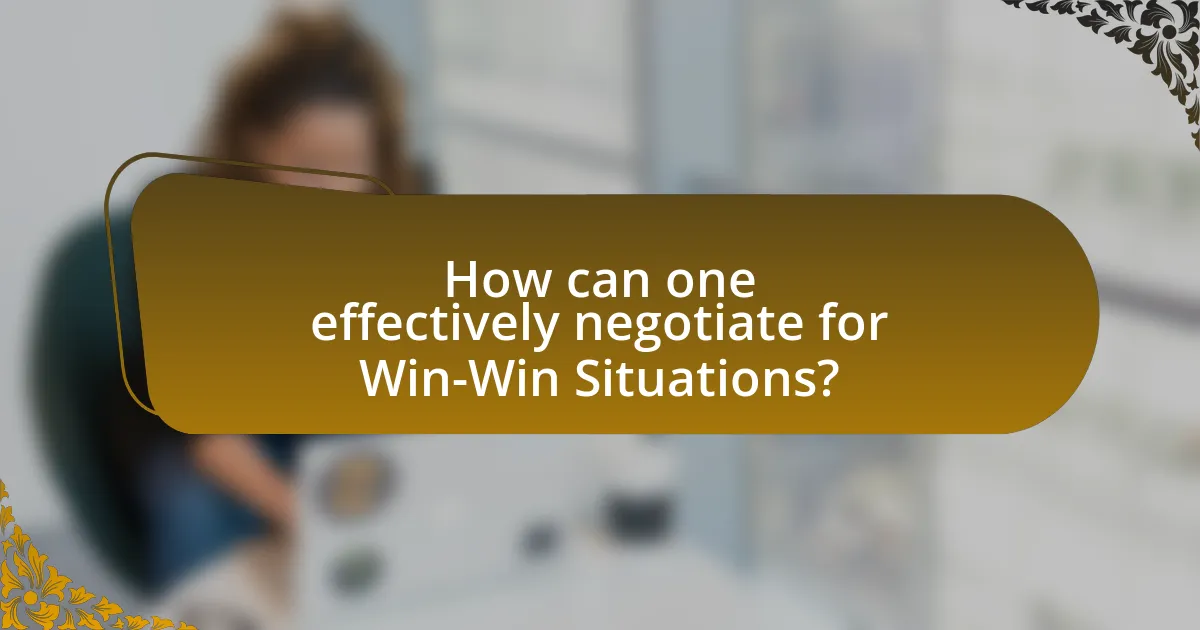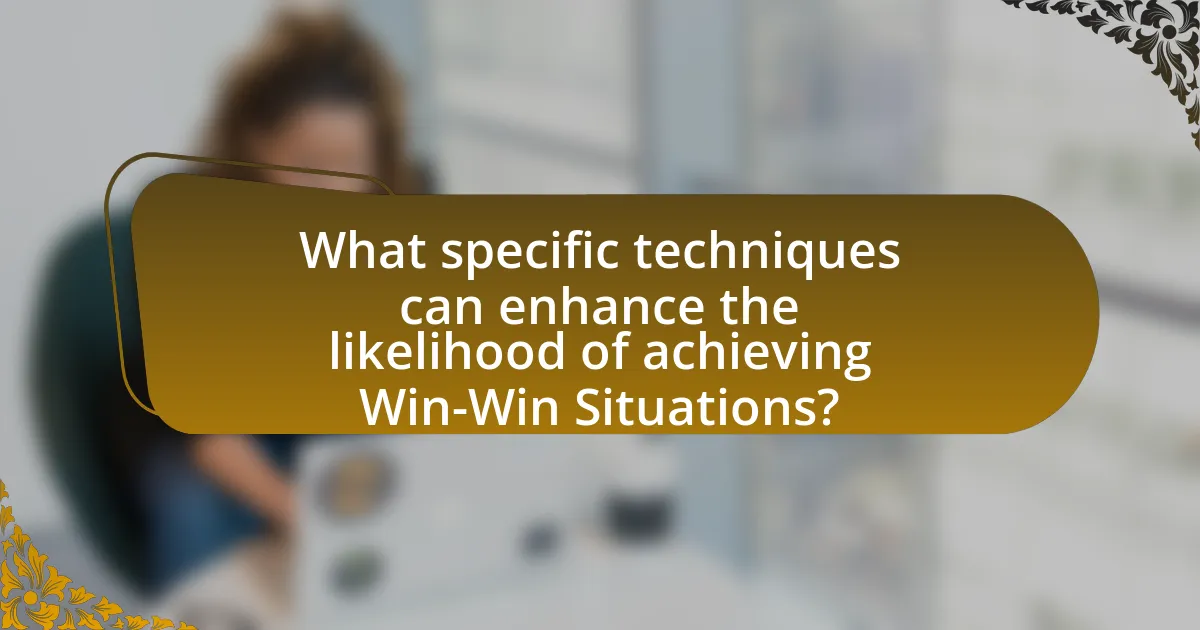Creating Win-Win Situations in negotiation involves achieving outcomes that benefit all parties involved, fostering collaboration and mutual satisfaction. This article outlines the principles of win-win negotiations, contrasting them with traditional adversarial approaches, and highlights the importance of understanding each party’s interests. Key characteristics of win-win situations include open communication, trust-building, and the use of integrative bargaining strategies. The article also discusses techniques for effective negotiation, such as active listening, empathy, and preparation, while identifying common pitfalls to avoid. By employing these strategies, negotiators can enhance relationships and achieve sustainable agreements that satisfy all stakeholders.

What are Win-Win Situations in Negotiation?
Win-win situations in negotiation refer to outcomes where all parties involved achieve mutual benefits and satisfaction. In these scenarios, negotiators collaborate to identify shared interests and create solutions that fulfill the needs of each side, rather than competing for limited resources. Research indicates that win-win negotiations can lead to stronger relationships and increased trust among parties, as they focus on cooperation rather than conflict. This approach is supported by the principle of integrative bargaining, which emphasizes the importance of understanding each party’s underlying interests to generate value for everyone involved.
How do Win-Win Situations differ from traditional negotiation outcomes?
Win-Win Situations differ from traditional negotiation outcomes in that they focus on mutual benefit rather than compromise. In traditional negotiations, parties often view the process as a zero-sum game where one party’s gain is another’s loss, leading to adversarial tactics. Conversely, Win-Win Situations prioritize collaboration, encouraging parties to explore creative solutions that satisfy the interests of all involved. Research by Fisher and Ury in “Getting to Yes” emphasizes that effective negotiation can lead to outcomes where both sides feel they have gained value, fostering long-term relationships and trust. This approach not only enhances satisfaction but also increases the likelihood of successful future negotiations.
What are the key characteristics of a Win-Win Situation?
A Win-Win Situation is characterized by mutual benefit, where all parties involved achieve their objectives and feel satisfied with the outcome. This scenario fosters collaboration, as it encourages open communication and understanding of each party’s needs and interests. Additionally, a Win-Win Situation promotes trust and long-term relationships, as it prioritizes shared success over individual gain. Research indicates that negotiations yielding Win-Win outcomes often lead to more sustainable agreements, as evidenced by studies in conflict resolution and negotiation theory, which highlight the effectiveness of integrative bargaining strategies.
Why is collaboration important in achieving Win-Win Situations?
Collaboration is crucial in achieving Win-Win situations because it fosters mutual understanding and shared goals among parties involved. When individuals or groups collaborate, they can combine their strengths, resources, and perspectives, leading to innovative solutions that satisfy the interests of all stakeholders. Research indicates that collaborative negotiation processes often result in higher satisfaction rates and better long-term relationships, as evidenced by a study published in the Journal of Conflict Resolution, which found that collaborative approaches yield more durable agreements compared to competitive tactics. This demonstrates that effective collaboration not only enhances the likelihood of achieving mutually beneficial outcomes but also strengthens partnerships for future interactions.
What are the benefits of creating Win-Win Situations?
Creating Win-Win Situations fosters mutual benefit, enhancing relationships and collaboration. These situations lead to increased trust between parties, as both feel valued and understood, which can result in long-term partnerships. Additionally, they often yield better outcomes, as solutions are crafted that satisfy the needs of all involved, leading to higher satisfaction and commitment. Research indicates that negotiations characterized by Win-Win outcomes can improve overall productivity and innovation, as stakeholders are more likely to share resources and ideas when they perceive equitable treatment.
How do Win-Win Situations enhance relationships between parties?
Win-Win Situations enhance relationships between parties by fostering mutual trust and collaboration. When both parties achieve their goals, it creates a sense of satisfaction and respect, which strengthens their connection. Research indicates that successful negotiations, characterized by win-win outcomes, lead to long-term partnerships and increased cooperation, as evidenced by a study published in the Journal of Conflict Resolution, which found that collaborative negotiation strategies significantly improve relationship quality. This positive dynamic encourages open communication and future collaboration, further solidifying the relationship between the involved parties.
What long-term advantages do Win-Win Situations provide?
Win-Win Situations provide long-term advantages such as enhanced relationships, increased trust, and sustainable solutions. These advantages stem from the collaborative nature of Win-Win outcomes, which prioritize mutual benefit over individual gain. Research indicates that negotiations resulting in Win-Win scenarios lead to higher satisfaction levels among parties, fostering ongoing partnerships and reducing conflict. For instance, a study published in the Journal of Conflict Resolution found that parties engaged in collaborative negotiations reported a 30% increase in relationship quality compared to those in competitive negotiations. This evidence supports the notion that Win-Win Situations contribute to long-lasting positive interactions and effective problem-solving.

How can one effectively negotiate for Win-Win Situations?
To effectively negotiate for Win-Win situations, one should prioritize open communication and mutual understanding. This involves actively listening to the other party’s needs and interests, which fosters a collaborative environment. Research indicates that successful negotiations often result from identifying shared goals and exploring creative solutions that satisfy both parties. For instance, a study by Fisher and Ury in “Getting to Yes” emphasizes the importance of focusing on interests rather than positions, leading to more innovative outcomes. By employing these strategies, negotiators can create agreements that benefit all involved, ensuring long-term relationships and satisfaction.
What strategies can be employed to foster collaboration in negotiations?
To foster collaboration in negotiations, parties can employ strategies such as active listening, establishing common goals, and building trust. Active listening ensures that all parties feel heard and understood, which can lead to more open communication and a willingness to collaborate. Establishing common goals aligns the interests of both sides, creating a foundation for cooperative problem-solving. Building trust through transparency and reliability encourages a collaborative atmosphere, as parties are more likely to share information and work together when they feel secure in the relationship. These strategies are supported by research indicating that effective communication and trust-building significantly enhance negotiation outcomes, leading to mutually beneficial agreements.
How can active listening contribute to Win-Win outcomes?
Active listening contributes to Win-Win outcomes by fostering mutual understanding and trust between negotiating parties. When individuals engage in active listening, they demonstrate genuine interest in the perspectives and needs of others, which can lead to more effective communication. Research indicates that effective communication is a key factor in successful negotiations, as it allows parties to identify common goals and areas for compromise. For instance, a study published in the Journal of Conflict Resolution found that negotiators who practiced active listening were more likely to reach agreements that satisfied both sides, thereby creating Win-Win situations.
What role does empathy play in successful negotiations?
Empathy plays a crucial role in successful negotiations by fostering understanding and building trust between parties. When negotiators demonstrate empathy, they are better able to recognize and appreciate the perspectives, needs, and emotions of the other party, which can lead to more collaborative and mutually beneficial outcomes. Research indicates that empathetic negotiators are more likely to achieve win-win solutions, as they can identify common ground and address concerns effectively. For instance, a study published in the Journal of Personality and Social Psychology found that negotiators who practiced empathy were able to create more value in negotiations compared to those who did not, highlighting the importance of empathy in achieving favorable results.
What common pitfalls should be avoided in negotiations?
Common pitfalls to avoid in negotiations include failing to prepare adequately, allowing emotions to dictate decisions, and not listening actively to the other party. Preparation is crucial; research shows that negotiators who prepare effectively are 30% more likely to achieve favorable outcomes. Emotional reactions can cloud judgment, leading to poor decisions; studies indicate that emotional intelligence plays a significant role in successful negotiations. Lastly, active listening fosters understanding and collaboration, as evidenced by findings that effective communicators can increase agreement rates by up to 50%.
How can adversarial tactics undermine Win-Win Situations?
Adversarial tactics can undermine Win-Win situations by fostering distrust and creating a competitive atmosphere that prioritizes individual gain over mutual benefit. When one party employs aggressive negotiation strategies, it can lead to defensiveness and retaliation from the other party, which disrupts open communication and collaboration. Research indicates that negotiations characterized by adversarial tactics often result in suboptimal outcomes, as parties become more focused on winning rather than finding solutions that satisfy both sides. For example, a study published in the Journal of Conflict Resolution found that competitive negotiation styles significantly decrease the likelihood of achieving integrative agreements, which are essential for Win-Win outcomes.
What are the consequences of failing to understand the other party’s needs?
Failing to understand the other party’s needs can lead to ineffective communication and unmet expectations. This misalignment often results in conflict, as both parties may feel frustrated and undervalued, which can derail negotiations. Research indicates that 70% of negotiations fail due to a lack of understanding of the other party’s interests (Harvard Business Review, “Negotiation Strategies,” 2020). Additionally, without recognizing these needs, one party may impose solutions that do not resonate, leading to a breakdown in trust and collaboration. Ultimately, this failure can prevent the achievement of mutually beneficial outcomes, leaving both parties dissatisfied.

What specific techniques can enhance the likelihood of achieving Win-Win Situations?
To enhance the likelihood of achieving Win-Win situations, effective communication, active listening, and collaborative problem-solving techniques are essential. Effective communication ensures that all parties clearly articulate their needs and interests, which fosters understanding and reduces misunderstandings. Active listening allows negotiators to fully comprehend the perspectives of others, demonstrating respect and openness, which can lead to more creative solutions. Collaborative problem-solving techniques, such as brainstorming and interest-based negotiation, encourage participants to work together to identify mutually beneficial outcomes. Research by Fisher and Ury in “Getting to Yes” emphasizes that focusing on interests rather than positions leads to better negotiation results, supporting the effectiveness of these techniques in creating Win-Win situations.
How can brainstorming lead to creative solutions in negotiations?
Brainstorming can lead to creative solutions in negotiations by fostering an open environment where diverse ideas are generated without immediate judgment. This process encourages participants to think outside conventional boundaries, allowing for innovative approaches to problem-solving. Research indicates that brainstorming sessions can increase the quantity and quality of ideas, as evidenced by a study published in the Journal of Applied Psychology, which found that groups engaged in brainstorming produced 20% more ideas than those who did not. By leveraging the collective knowledge and perspectives of all parties involved, brainstorming enhances collaboration and can uncover mutually beneficial solutions that may not have been considered otherwise.
What methods can be used to identify mutual interests?
To identify mutual interests, effective methods include open communication, active listening, and collaborative brainstorming. Open communication allows parties to express their needs and desires clearly, fostering an environment where mutual interests can surface. Active listening ensures that each party understands the other’s perspective, which can reveal common goals or values. Collaborative brainstorming encourages creative solutions that satisfy the interests of all involved, often leading to innovative compromises. Research indicates that these methods enhance negotiation outcomes by promoting understanding and cooperation, as demonstrated in studies on negotiation strategies published in the Journal of Conflict Resolution.
How can parties prioritize options to find common ground?
Parties can prioritize options to find common ground by identifying shared interests and evaluating the importance of each option based on mutual benefits. This process involves open communication where each party articulates their needs and preferences, allowing for a clearer understanding of what is essential for both sides. Research indicates that collaborative negotiation strategies, such as interest-based bargaining, enhance the likelihood of reaching agreements that satisfy all parties involved. For instance, a study by Fisher and Ury in “Getting to Yes” emphasizes the significance of focusing on interests rather than positions, which facilitates the discovery of solutions that accommodate the priorities of both parties.
What role does preparation play in successful negotiations?
Preparation is crucial in successful negotiations as it equips negotiators with the necessary information, strategies, and confidence to achieve favorable outcomes. Effective preparation involves researching the interests and needs of all parties, understanding the context of the negotiation, and developing clear objectives. Studies show that negotiators who prepare thoroughly are more likely to reach agreements that satisfy both sides, as they can anticipate challenges and respond effectively. For instance, a study published in the Journal of Applied Psychology found that negotiators who engaged in extensive preparation achieved better results compared to those who did not, highlighting the importance of being well-prepared in fostering collaborative deals.
How can thorough research improve negotiation outcomes?
Thorough research can significantly improve negotiation outcomes by providing negotiators with critical information about the interests, needs, and constraints of all parties involved. This knowledge enables negotiators to identify common ground and potential areas for compromise, which are essential for creating win-win situations. For instance, a study published in the Journal of Conflict Resolution found that negotiators who conducted comprehensive research were 30% more likely to reach mutually beneficial agreements compared to those who did not. By understanding the context and background of the negotiation, parties can craft proposals that are more appealing and relevant, ultimately leading to more successful and collaborative deals.
What tools can assist in preparing for a collaborative negotiation?
Tools that can assist in preparing for a collaborative negotiation include negotiation software, communication platforms, and collaborative frameworks. Negotiation software, such as Zaius or Negotiation360, helps parties analyze interests, track progress, and simulate outcomes, enhancing strategic planning. Communication platforms like Slack or Microsoft Teams facilitate real-time discussions and document sharing, ensuring all parties are aligned. Collaborative frameworks, such as interest-based negotiation or the Harvard Negotiation Project principles, provide structured approaches to identify mutual gains and foster cooperation. These tools collectively enhance preparation effectiveness, leading to more successful collaborative negotiations.
What are some best practices for maintaining a Win-Win mindset?
To maintain a Win-Win mindset, prioritize open communication and active listening during negotiations. Open communication fosters trust and ensures that all parties feel heard, which is essential for collaborative problem-solving. Active listening allows negotiators to understand the needs and interests of others, facilitating the identification of mutually beneficial solutions. Research indicates that effective communication can lead to higher satisfaction in negotiations, as demonstrated in studies by the Program on Negotiation at Harvard Law School, which emphasize the importance of understanding different perspectives to achieve successful outcomes.
How can negotiators remain flexible during discussions?
Negotiators can remain flexible during discussions by actively listening to the other party’s needs and adapting their strategies accordingly. This approach allows negotiators to identify common ground and explore alternative solutions that satisfy both parties. Research indicates that effective negotiators often employ techniques such as reframing issues, asking open-ended questions, and being willing to adjust their positions based on new information or perspectives. For instance, a study published in the Journal of Conflict Resolution highlights that negotiators who demonstrate adaptability are more likely to achieve mutually beneficial outcomes, as they can pivot their tactics in response to the dynamics of the conversation.
What techniques can help in managing emotions during negotiations?
Techniques that can help in managing emotions during negotiations include active listening, emotional awareness, and reframing. Active listening allows negotiators to fully understand the other party’s perspective, which can reduce emotional tension. Emotional awareness involves recognizing one’s own feelings and those of others, enabling better control over reactions. Reframing helps in viewing the situation from a different angle, which can alleviate negative emotions and foster a more collaborative atmosphere. Research indicates that these techniques can lead to more effective communication and improved outcomes in negotiations, as they promote empathy and understanding, essential components for creating win-win situations.
